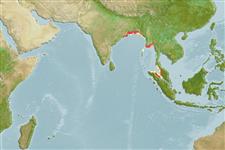Environment: milieu / climate zone / depth range / distribution range
Ökologie
seewasser; tiefenbereich 0 - 50 m (Ref. 189). Tropical; 25°N - 3°N, 85°E - 101°E (Ref. 189)
Eastern Indian Ocean: northeastern Bay of Bengal, from Calcutta south to the Indian Ocean coast of Thailand, perhaps to Pinang.
Size / Gewicht / Alter
Maturity: Lm ? range ? - ? cm
Max length : 16.5 cm SL Männchen/unbestimmt; (Ref. 189)
Rückenflossenstacheln (insgesamt) : 0; Afterflossenstacheln: 0; Afterflossenweichstrahlen: 41 - 45. Belly with 16 (rarely 17) + 11 to 13 = 27 to 29 keeled scutes from isthmus to anus. Tip of snout on level with upper rim of eye. Maxilla moderate, projecting a little beyond gill cover; first supra-maxilla minute, usually absent; teeth in jaws enlarged, especially in lower jaw. A dark blotch indistinct or absent behind upper part of gill opening; no dark lines along back.
Presumably schooling and inshore. More data needed.
Life cycle and mating behavior
Maturities | Fortpflanzung | Spawnings | Egg(s) | Fecundities | Larven
Wongratana, T., T.A. Munroe and M. Nizinski, 1999. Order Clupeiformes. Engraulidae. Anchovies. p. 1698-1753. In K.E. Carpenter and V.H. Niem (eds.) FAO species identification guide for fishery purposes. The living marine resources of the WCP. Vol. 3. Batoid fishes, chimaeras and bony fishes part 1 (Elopidae to Linophrynidae). FAO, Rome. (Ref. 9822)
IUCN Rote Liste Status (Ref. 130435)
Bedrohung für Menschen
Harmless
Nutzung durch Menschen
Tools
Zusatzinformationen
Download XML
Internet Quellen
Estimates based on models
Preferred temperature (Ref.
123201): 27.9 - 29.4, mean 28.7 °C (based on 68 cells).
Phylogenetic diversity index (Ref.
82804): PD
50 = 0.5000 [Uniqueness, from 0.5 = low to 2.0 = high].
Bayesian length-weight: a=0.00437 (0.00186 - 0.01024), b=3.11 (2.93 - 3.29), in cm total length, based on LWR estimates for this Genus-body shape (Ref.
93245).
Trophic level (Ref.
69278): 3.4 ±0.5 se; based on size and trophs of closest relatives
Widerstandsfähigkeit (Ref.
120179): hoch, Verdopplung der Population dauert weniger als 15 Monate. (Preliminary K or Fecundity.).
Fishing Vulnerability (Ref.
59153): Low vulnerability (10 of 100).
